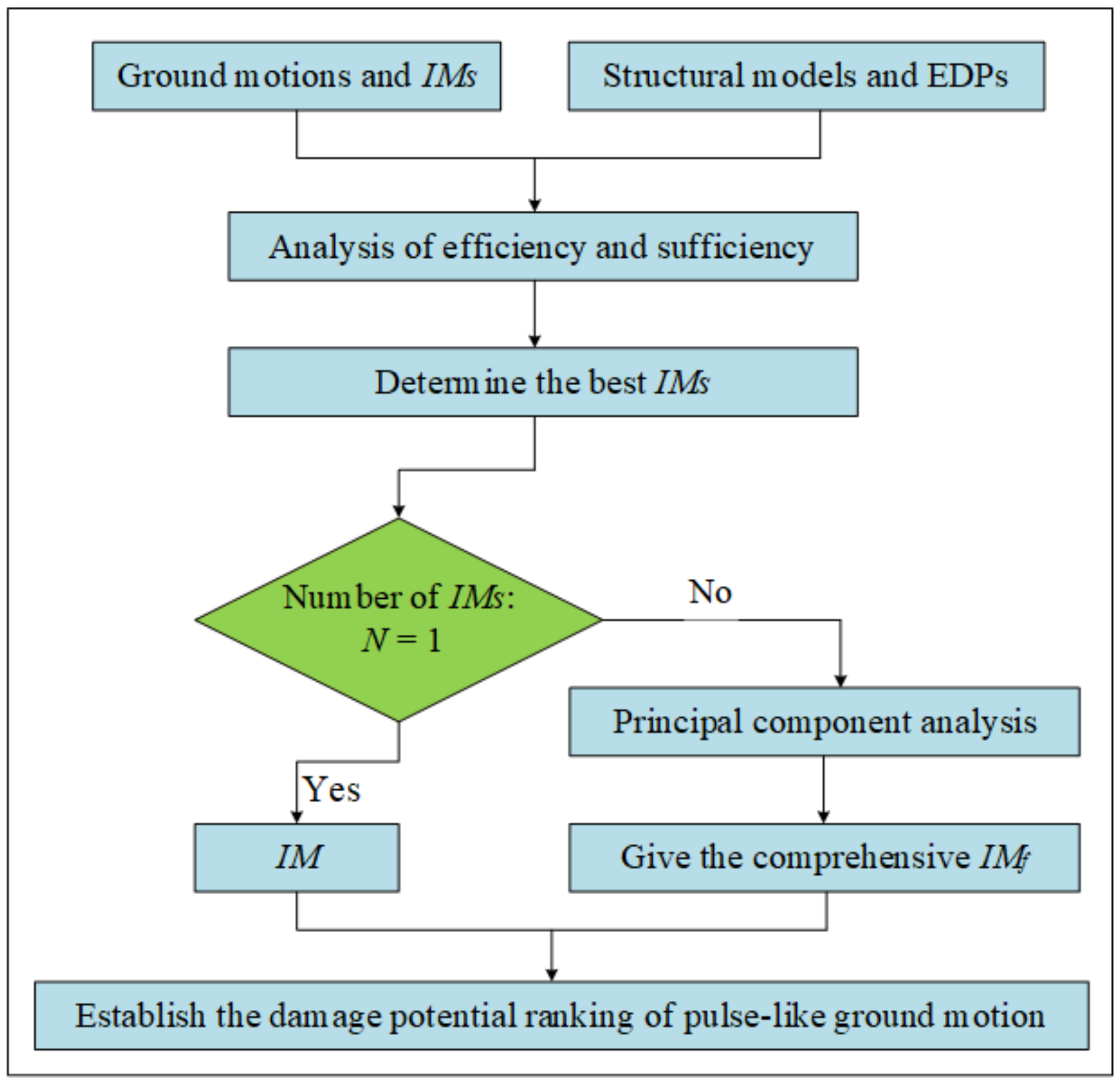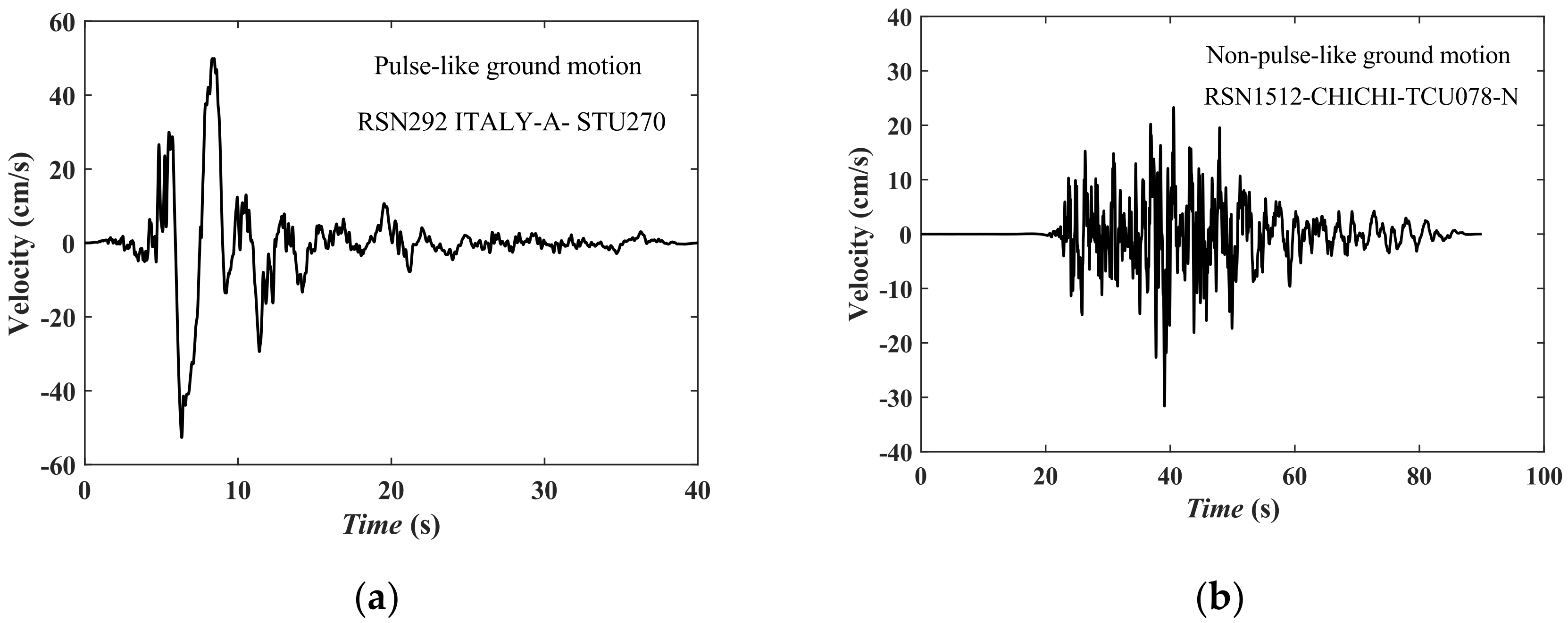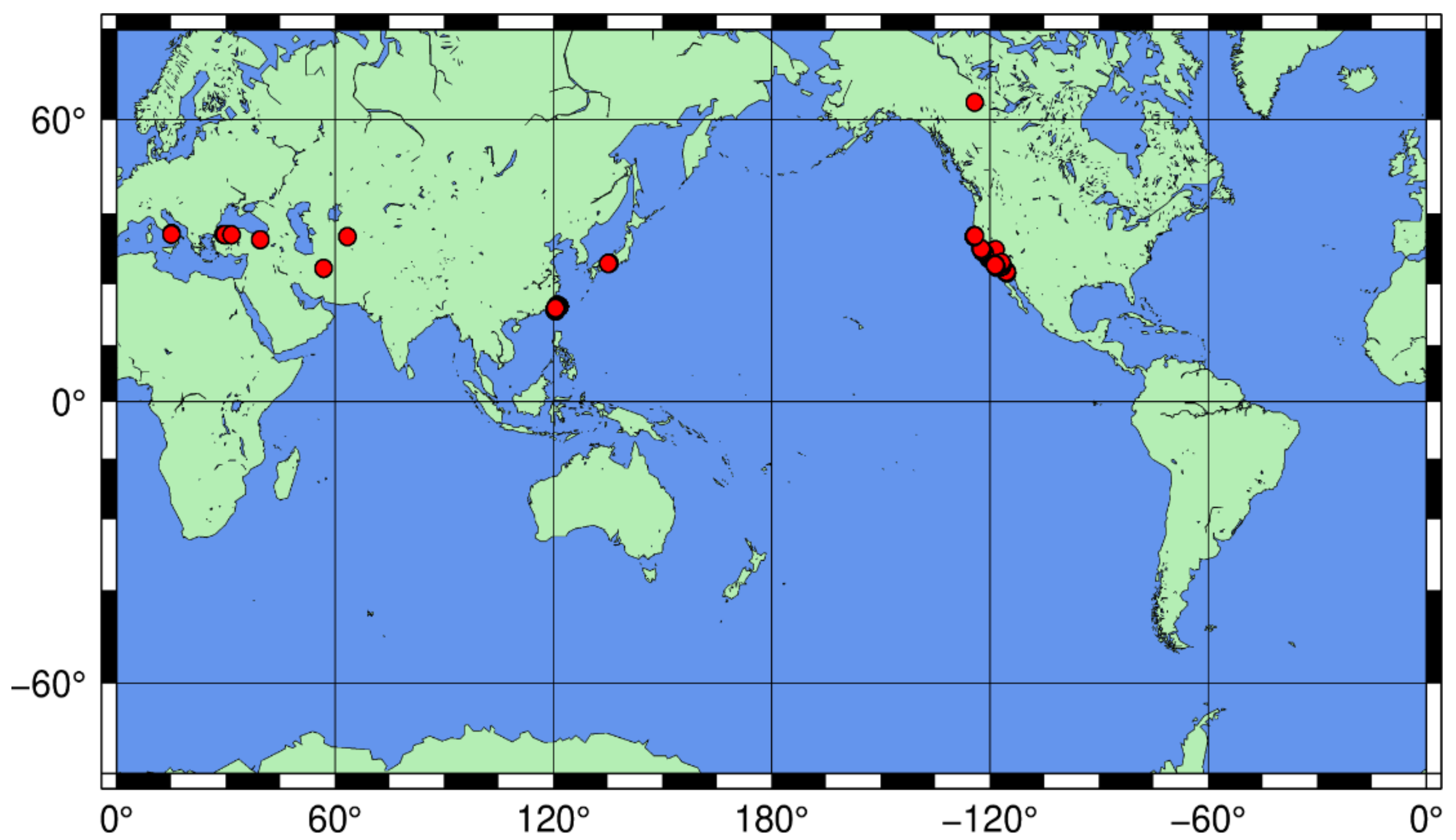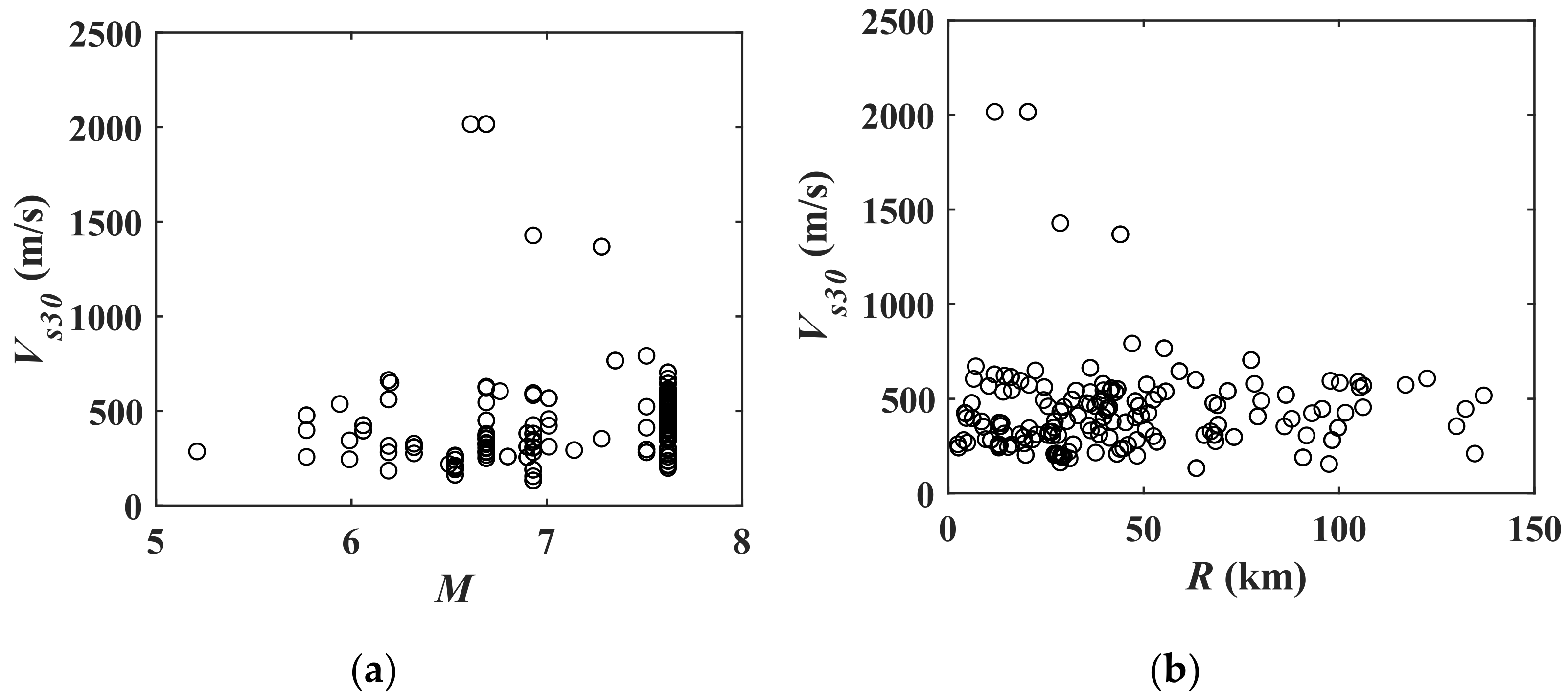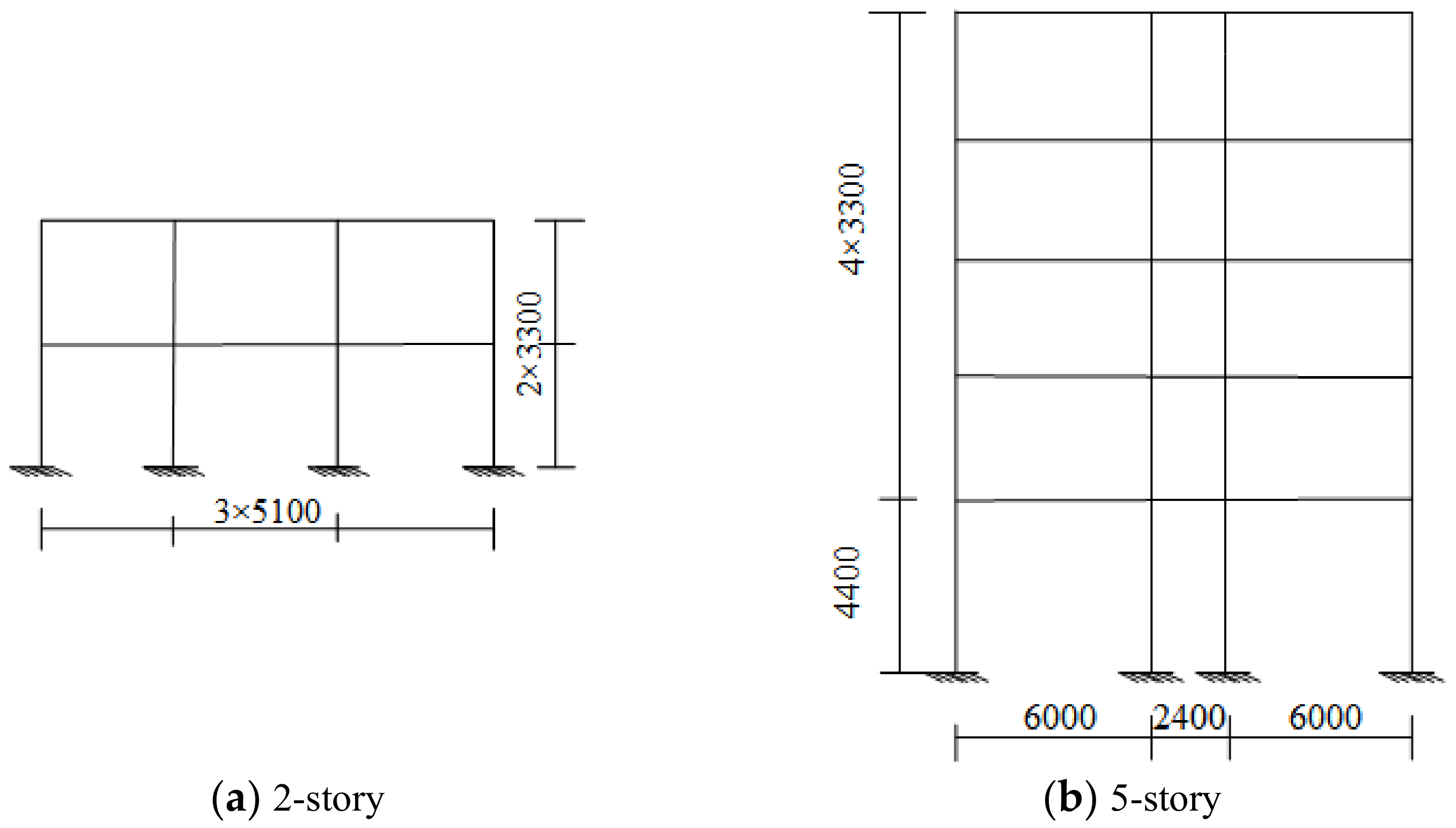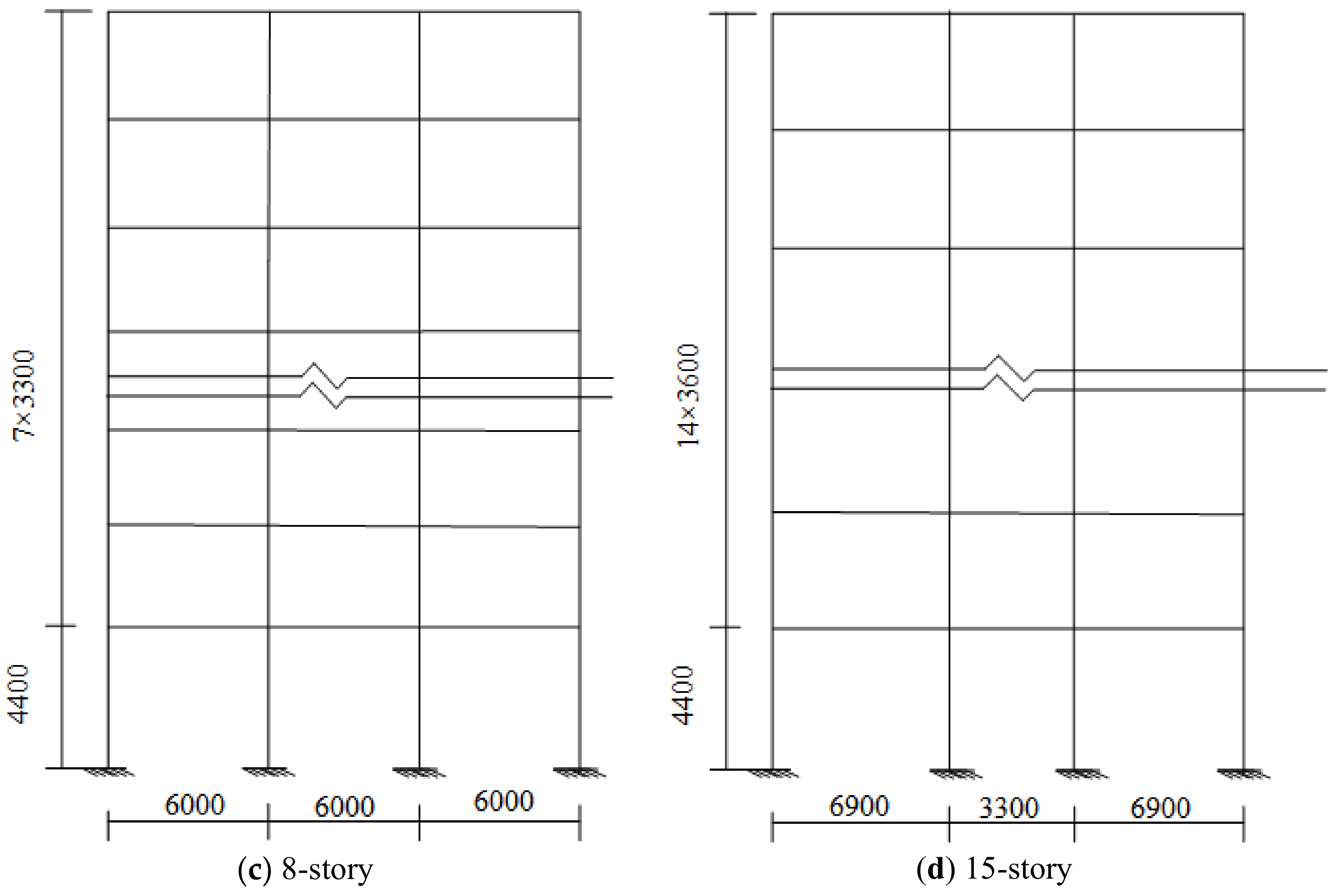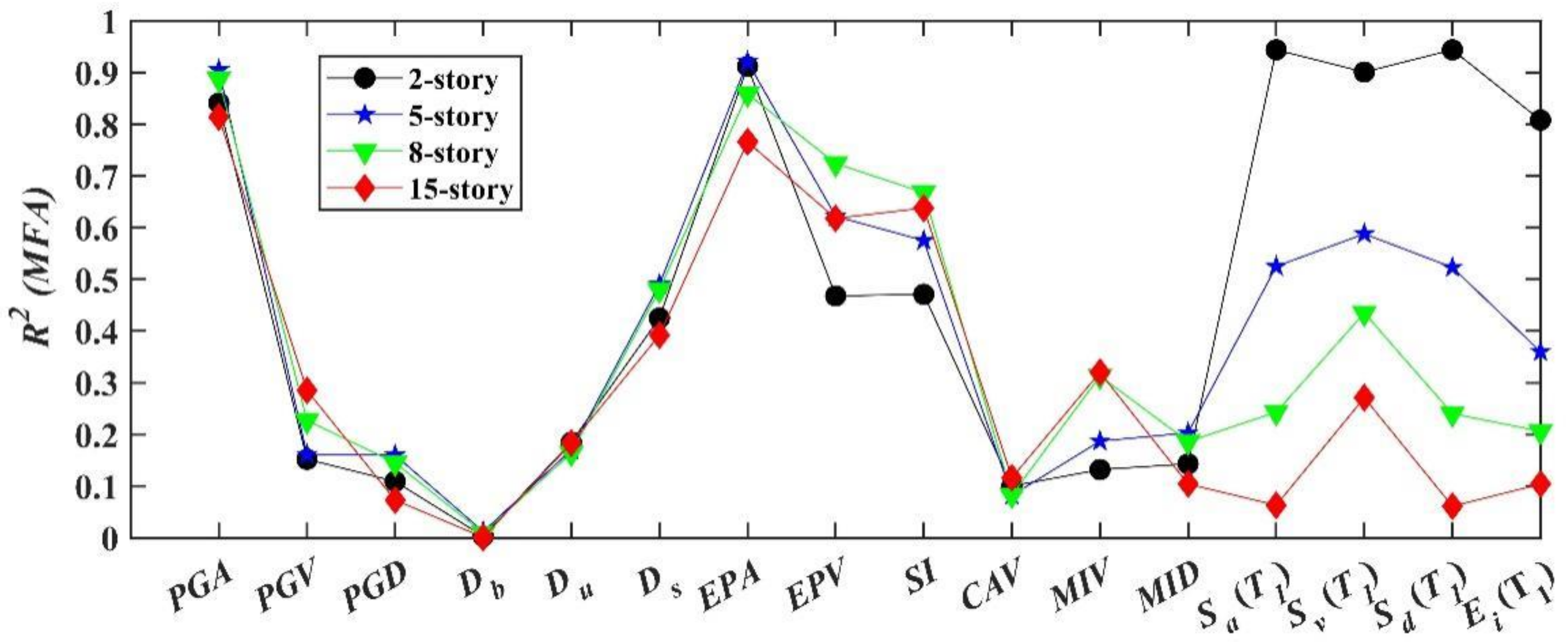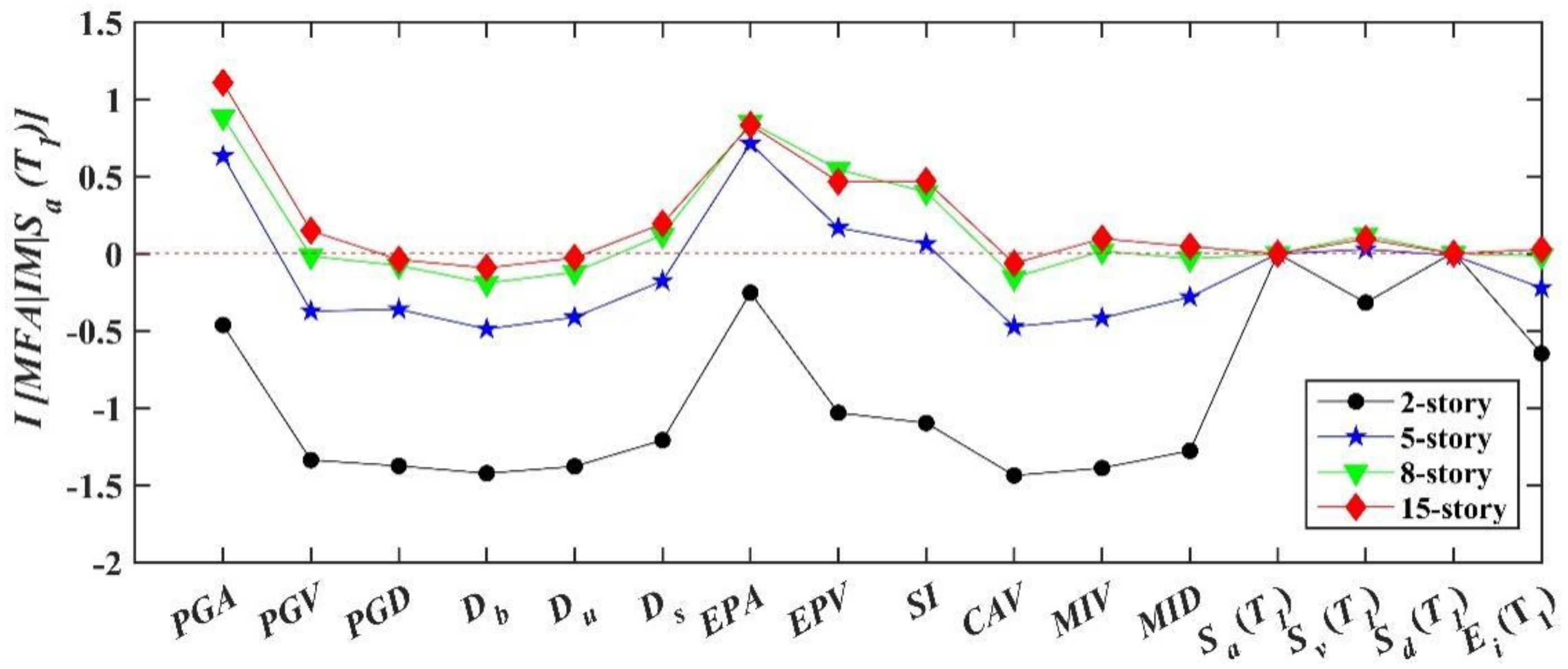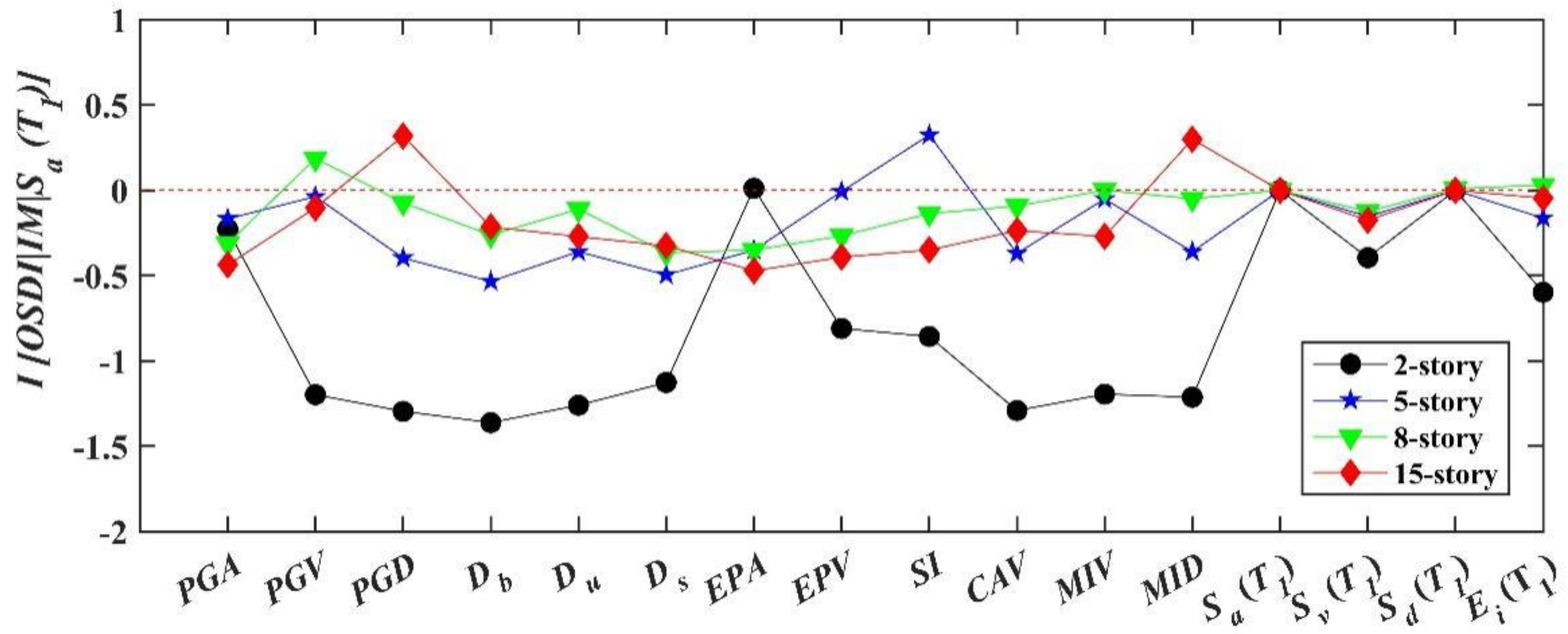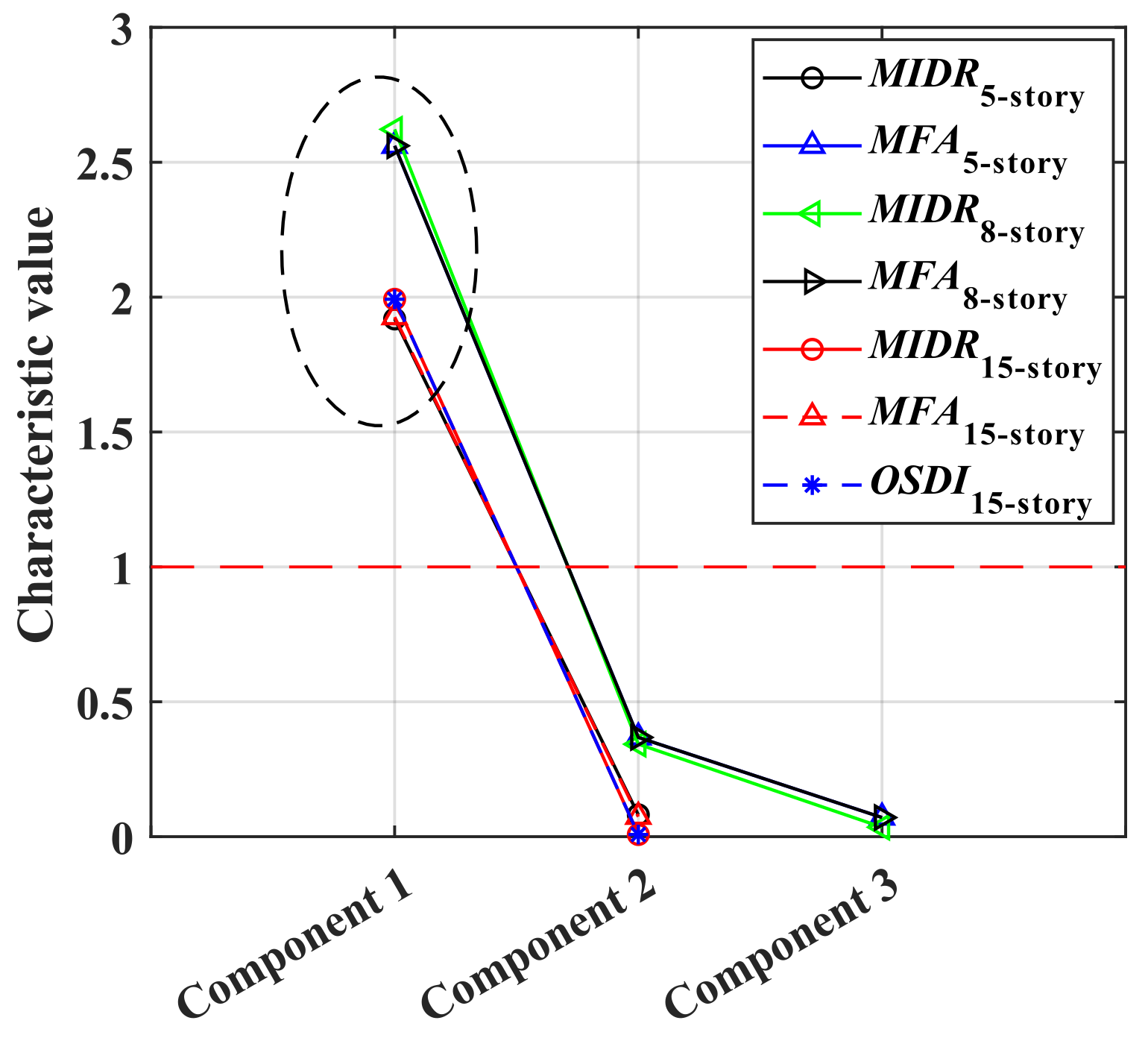1. Introduction
Ground motion damage to building structures is of two types: (1) cumulative damage, which occurs due to ground motion at medium and faraway sites; (2) instantaneous damage, which primarily occurs due to the destructive pulse-like ground motion. The mechanisms of the two types of ground motion damage are different. The damage potential of pulse-like ground motions for building structures is more significant compared with that of ordinary ground motions [
1,
2,
3,
4]. Therefore, the damage potential of pulse-like ground motions must be accurately evaluated for the seismic design of building structures. To estimate the damage potential of ground motions for building structures, two intermediate variables are introduced—one represents structural performance and the other represents ground motion characteristics [
5,
6,
7,
8]. An intensity measure (
IM) that has a strong correlation with the appropriate engineering demand parameter (
EDP) must be selected. However, several
IMs can be used to predict structural responses by establishing a seismic demand model between
IMs and
EDPs [
3,
9,
10]. Yazdani and Yazdannejad [
11] noted that the uncertainties associated with the seismic demand model are related to uncertainties associated with ground motions.
A few studies have focused on commonly used
IMs such as peak ground acceleration (
PGA), peak ground velocity (
PGV), peak ground displacement (
PGD), Arias intensity (
AI), specific energy density (
SED), and cumulative absolute velocity (
CAV) [
12]. However, these
IMs are based only on ground motion characteristics, and the uncertainties associated with structural performance are not considered. The more ground motion information and structural information an
IM contains, the better the correlation with
EDPs is. Compared with the aforementioned
IMs, the first-order spectral acceleration (
Sa (
T1)) is the most extensively used
IM in seismic risk analysis and structural seismic analysis [
13,
14,
15,
16,
17,
18,
19].
Sa (
T1) presents a high degree of correlation with the
EDPs of structures with small natural vibration periods. However, several studies [
20,
21] have discovered that there is a low degree of correlation between the
Sa (
T1) and
EDPs of super-high-rise buildings. To this end, some experts have selected relative displacement (
Sd (
T1)) or input energy (
Ei (
T1)) as the
IMs for predicting structural responses [
18,
22]. A few studies have focused on achieving discreteness in vector
IMs and
EDPs [
23,
24]; the discreteness achieved in vector
IMs and
EDPs is smaller than that in scalar
IMs. However, vector
IMs are complex and thus not conducive to practical engineering applications. To avoid the complexities associated with the use of vector
IMs, scalar
IMs can be used instead, especially when the same capacity for predicting
EDPs can be achieved using scalar
IMs [
25,
26].
Significant uncertainties are prevalently associated with structural performance. However, in some studies, only a few similar structures have been comprehensively analyzed via non-linear time-history analysis [
9,
20,
26,
27]; the results obtained in this direction are consistent. Ebrahimian [
9] analyzed the prediction capacities of different
IMs for the structural responses of four-story and six-story isolated structures, which were subjected to pulse-like ground motions and ordinary ground motion. The results implied that the vector
IMs related to
Sa (
T1) could be used to predict structural responses more efficiently and sufficiently. Dávalos and Miranda [
26] analyzed the efficiency and sufficiency of
FIV3 in predicting the structural responses of a four-story reinforced concrete (RC) frame. The results indicated that the novel
FIV3 is a promising parameter that can be used for assessing structural collapse risks. Furthermore, some researchers have investigated the correlation between the
IMs and structural responses of different structures. Palanci [
28] analyzed the correlation between the average values of spectral displacement over different periods via the SDOF system involving different hysteretic models. However, in this study, the correlation between different
IMs and the average values of
EDPs of different structures is investigated to determine the prediction capacities of
IMs, without considering the uncertainties associated with the structures. Note that the correlations between the
EDPs and different
IMs are significantly different for structures with different natural vibration periods [
29,
30,
31]. Yakhachalian and Ghodrati [
29] analyzed the discreteness of
IMs and
EDPs for low- and middle-rise structures via the strip method. The vector
IM (
Sa (
T1),
Sa (
T1)/
PGV) is proposed as an optimal
IM for predicting the maximum inter-story drift ratio (
MIDR) for low- and middle-rise RC moment-resisting frame structures.
However, the aforementioned studies have only verified the prediction capacity of the selected IMs for different structures; meanwhile, few studies have used the obtained IMs to further analyze ground motion characteristics. The damage potential of ground motions for building structures can be determined based on different IMs. Notably, ground motions, especially pulse-like ground motions, have not been ranked based on the optimal IMs in the aforementioned studies. In this study, pulse-like ground motions are ranked based on their damage potential for different RC frame structures.
2. Technical Framework
To rank the ground motions in predicting
EDPs based on the damage potential, a method is proposed for ranking pulse-like ground motions according to their damage potential in this study; the method involves predicting
EDPs based on ground motion
IMs. The uncertainties associated with both ground motions and building structures are considered in the proposed method. The 16 selected
IMs include amplitude, spectrum, and duration, which can be used to describe the uncertainties associated with ground motions. Meanwhile, four reinforced concrete (RC) frame structural models with significantly different natural vibration periods are established, and three
EDPs are considered for evaluating the uncertainty of the established structures. The efficiency and sufficiency of
IMs in predicting
EDPs are analyzed to determine the optimal
IMs for different structures. Furthermore, for multiple optimal
IMs, the pulse-like ground motions are ranked by determining the comprehensive
IM via the principal component analysis (PCA) method. Finally, the pulse-like ground motions are ranked according to their damage potential using the selected optimal
IM. The technical framework of this paper is illustrated in
Figure 1.
5. Prediction and Analysis of EDPs Based on IMs
The capacity of an
IM for predicting
EDPs is primarily determined via analyzing the efficiency and sufficiency of the
IM. In traditional methods [
32,
35], the numerical values of
IMs and
EDPs are typically assumed to have linear or logarithmic distribution, as shown in Equations (1) and (2). The aim of this study is to rank pulse-like ground motions based on their damage potential. To this end, a new data-processing method is proposed. The
IMs that can be used to efficiently and sufficiently predict
EDPs are positively correlated with
EDPs.
IMs and
EDPs are separately used to rank ground motions, which are ranked based on
IMs and
EDPs, respectively, and the relationship between the two ranking results (
RIM and
REDP) is shown in Equation (3). The efficiency and sufficiency of an
IM is determined by the ability of the
IM to predict
EDP.
where
b0 and
b1 are regression coefficients,
RIM is the ranking obtained using an
IM, and
REDP is the ranking obtained using an
EDP.
5.1. Efficiency of the IMs
Efficiency is an important metric for assessing the quality of a selected
IM. There are two commonly used statistical parameters that can be used to describe the efficiency of
IMs [
9,
40]. The first parameter is the determination coefficient (
R2), as shown in Equation (4). A value of
R2 is closer to one; the efficiency of the
IM increases with the decrease in the discreteness of
IM ranking and
EDP ranking fitting. The second statistical parameter is the standard deviation
βD|IM. The greater the value of
βD|IM, the smaller the dispersion, which means that the regression model is more efficient for characterizing the structural response. Either of the statistical parameters can be used to effectively measure the efficiency of
IMs.
R2 is used as the criterion in this study.
where
n denotes the number of ground motion data points;
denotes the response fitting ranking based on the
IM ranking;
is the average ranking of
EDP;
is the
EDP ranking.
The efficiencies of the
IMs are analyzed based on the structural responses of the four structures, and the calculation results are shown in
Figure 7,
Figure 8 and
Figure 9. Notably, the uncertainties associated with ground motion and building structure should be considered while analyzing the damage potential of ground motion for building structures. There are notable differences between the discreteness of the same
IM and the same
EDP for different structures. Furthermore, the discreteness of the same
IM and different
EDPs may also be different for the same structure. These results indicate the uncertainties associated with structure. However, in many studies, only similar structures have been analyzed, and the results are inconsistent with the findings of this study [
9,
26].
In addition, there are significant differences between the R2 values of different IMs and EDPs for the same structure; this indicates the uncertainties associated with ground motion.
The uncertainties associated with ground motion and building structure are considered in this study for analyzing the ability of
IMs to predict
EDPs accurately and to determine the optimal
IMs for describing the damage potential of ground motion. Three
IMs with the largest
R2 for
EDP prediction are selected for the different structural types and
EDPs. The results are shown in
Table 6. The results indicate that even for the same
EDP, the most efficient
IMs are different for different structural types. When
MIDR is selected as the
EDP, the most efficient
IMs are different for different building types:
EPA,
Sa (
T1), and
Sd (
T1) are the most efficient
IMs for two-story buildings;
SI,
EPV, and
Sa (
T1) are the most efficient
IMs for five-story buildings;
PGV,
Sd (
T1), and
E(
T1) are the most efficient
IMs for eight-story buildings, and
PGD,
MID, and
Sd (
T1) are selected as the most efficient
IMs for 15-story buildings. The
IMs that can be used to predict
OSDI and
MIDR are the same in most cases. Some
IMs related to acceleration can be used to efficiently characterize
MFA, such as
PGA,
EPA, and
Sa (
T1).
5.2. Sufficiency of the Selected IMs
In addition to efficiency, sufficiency is important for assessing the quality of
IMs. An
IM is sufficient when the probability distribution of an
EDP is independent from ground motion characteristics, such as epicenter distance, magnitude, and the ground motion parameter epsilon (
ε) [
41]. Zelaschi et al. [
40] obtained
p-values for the residuals of
EDP and
with magnitude and epicenter distance of the ground motion when they proved that an
IM is sufficient. Similar methods [
20,
29,
42] have been used in relevant studies to demonstrate the sufficiency of
IMs. However, the method proposed by Zelaschi et al. is unreasonable because the calculated
p-values are closely related to the number of samples, as noted in relevant studies [
40,
43]. It becomes more difficult to accept the null hypothesis with an increasing number of samples.
The sufficiency of an
IM can also be verified based on relative entropy, a concept in seismic engineering proposed by Jalayer [
27]. In this study, based on the concept of relative entropy, a simple quantitative measure is introduced; it is called the relative sufficiency measure, which is selected as a parameter to measure the relative sufficiency of one
IM with respect to another. Therefore, the relative sufficiency measure is used to verify the sufficiency of the selected
IMs. The simplified and approximate formulation of relative sufficiency is shown in Equation (5).
where
βD|IM is the conditional standard deviation, which serves as a quantitative measure for the prediction efficiency of the
IMs;
yk is the
REDP; ln
ηD|IM is the fitting function;
n is the number of samples.
The above equation was derived by Jalayer [
27] and Ebrahimian [
9]. The reference intensity (i.e.,
IM1 in Equation (5)) is considered to be
Sa (
T1) for the structural response, mainly because
Sa (
T1) is a better characterization parameter for the structural response and is extensively used in earthquake engineering. The sufficiency is measured for each candidate
IM relative to
Sa (
T1).
If (IM2|IM1) has a positive value, the candidate IM is more sufficient than Sa (T1). Similarly, if I (IM2|IM1) has a negative value, the candidate IM is less sufficient than Sa (T1) for predicting EDPs.
The obtained results, as shown in
Figure 10,
Figure 11 and
Figure 12, indicate that one or more
IMs are more sufficient than
Sa (
T1) for characterizing the
EDPs in most cases. However, when analyzing
MFA and
MIDR for a two-story structure, all
values are not positive, which indicates that
Sa (
T1) is the most sufficient among all parameters. Finally, all the most sufficient
IMs for characterizing the
EDPs are obtained, as shown in
Table 7.
5.3. Comprehensive Analysis of the Selected IMs
The efficiency and sufficiency of 16
IMs are analyzed to determine the optimal
IMs for accurately describing the damage potential of ground motions. The ground motion
IMs that satisfy the requirements of both efficiency and sufficiency are determined by comparing the analysis results for efficiency and sufficiency, as shown in
Table 8. For a short-period structure (for example, two-story) and
MFA as the
EDP, the acceleration-related
IMs can be used to efficiently and sufficiently characterize the
EDPs. For
MIDR or
OSDI as the
EDP and a medium-period structure (for example, eight-story), the velocity-related
IMs can be used to efficiently and sufficiently characterize the
EDPs. Finally, the displacement-related
IMs can be used to efficiently and sufficiently characterize the MIDR or
OSDI for a long-period structure (for example, 15-story).
6. Establishing the Pulse-like Ground Motion Rankings
To describe the destructive capacity of ground motion more accurately and rank the pulse-like ground motions based on the optimal
IMs, the efficiency and sufficiency of 16
IMs are analyzed by four different structures. However, there are two cases based on the number of
IMs, as shown in
Table 8: (1) only one optimal
IM is obtained, and the pulse-like ground motions are ranked directly based on this
IM, which is the damage potential ranking result of the pulse-like ground motions; the ranking depicts the ranking in which the ground motions can damage a building structure—the most unfavorable to the most favorable; (2) multiple
IMs are obtained. However, further analysis is necessary for developing a ranking method in the case of multiple
IMs.
A novel method is proposed for combining multiple
IMs into one comprehensive
IM. The method involves reducing the dimensions of the variables via PCA. Subsequently, the damage potential of pulse-like ground motion is comprehensively evaluated according to the principal component. The results are highly interpretable [
44,
45,
46].
6.1. Comprehensive IM Determination Based on the PCA
The proposed method is a multivariate statistical method that involves dimensional reduction and the transformation of multiple indicators into a few comprehensive indicators, while ensuring minimal loss of data or information. Generally, the comprehensive IM generated via transformation is called the principal component, which is a linear combination of original variables. Based on the principal component, the main contradictions can be identified and the collinearity problem between variables can be avoided, and thus the efficiency of the IM can be improved.
For example, there are n samples, and each sample contains p variables. A strong correlation exists among these p variables, which is denoted by X = (
x1,
x2, …,
xp)’ after standardization. The mathematical model of PCA is shown in Equation (6).
is an orthogonal matrix as shown in Equation (7).
where
y1,
y2, …,
yp are the principal components. The determination steps of the comprehensive
IM based on PCA are as follows.
Step 1: The correlation coefficient matrix is calculated to test whether the variables to be analyzed are suitable for PCA. According to the results in
Table 8, there are seven cases for which PCA can be applied: (1)
MIDR of 5-story, (2)
MFA of 5-story, (3)
MIDR of 8-story, (4)
MFA of 8-story, (5)
MIDR of 15-story, (6)
MFA of 15-story, and (7)
OSDI of 15-story. The correlation coefficients for
IMs under all conditions are depicted in
Table 9. Notably, when a high degree of correlation exists between the two
IMs under all cases, PCA can be performed.
Step 2: The characteristic values of the correlation coefficient matrix are calculated under seven cases, and the calculation results are shown in
Figure 13.
Step 3: The number of principal components is determined. There are two situations associated with the determination of the principal component: (1) the cumulative contribution rate of the principal component reaches a certain probability; (2) the characteristic value is greater than one. The second situation is applied to this study. Based on the characteristic values shown in
Figure 13, the number of principal components obtained is one. Therefore, only one principal component
f1 can be used to characterize the damage potential of ground motions.
Step 4: The pulse-like ground motions are ranked based on the principal components. The pulse-like ground motions can be ranked directly based on the first principal component
f1. Each principal component need not be added to determine the comprehensive score.
Table 10 shows the correlation coefficients and component score coefficients between the principal component
f1 and
IMs under the same case. Note that the principal component is highly correlated with other parameters. The principal component
f1 is calculated as shown in Equation (8).
where
c1,
c2, …,
cn are the score coefficients of different
IMs;
n is the number of
IMs.
6.2. Ranking of Pulse-like Ground Motions According to Damage Potential
The pulse-like ground motions are ranked according to the selected
IMs under different cases, as shown in
Table 11. If only one
IM is obtained in certain cases, the pulse-like ground motions can be ranked directly based on that
IM. In addition, the pulse-like ground motions are ranked according to the principal component
f1. Furthermore, the ranking results are obtained for the damage potential of pulse-like ground motions for different structures. The ranking results are shown in
Appendix A. Due to the large number of ground motion data points, only a few of the ranked ground motion data points are given. The remaining data points are entered in an MS Excel spreadsheet.
7. Discussion
It is well known that the damage potential of pulse-like ground motions is greater than that of ordinary ground motions. However, previous studies have not yet quantitatively measured the damage potential of pulse-like ground motions for different structures. To solve this challenge, this study proposed a new method to rank pulse-like ground motions based on the damage potential. The method was developed based on 240 pulse-like ground motions and 16 IMs. IMs were employed to describe the damage potential of ground motions, and EDPs were used to characterize the damage state of structures. The relationship between the IMs and EDPs was analyzed based on four representative RC frame structures to cover a wide range of natural vibration periods, which can better represent the variety of actual structures than the traditional studies with close natural vibration periods. The results of this study indicate that there are notable differences between the discreteness of the IMs and the EDPs for the RC frame structures with different natural vibration periods. When MFA is used as the EDP, the acceleration-related IMs can be used to efficiently and sufficiently characterize MFA for all four structures. When MIDR or OSDI is used as the EDP, the acceleration-related, velocity-related, and displacement-related IMs can be used to efficiently and sufficiently characterize EDP for short-period structures (e.g., two-story), medium-period structures (e.g., eight-story), and long-period structures (e.g., fifteen-story), respectively.
In addition, the two cases on the selected
IMs shown in
Table 8 indicate that: (1) only one optimal
IM was obtained for the structures with different natural vibration periods and
EDPs, respectively; (2) multiple
IMs were obtained, the PCA method was employed to obtain a comprehensive
IM to characterize the damage potential of pulse-like ground motions for specific building structures and
EDPs. The pulse-like ground motions were ranked based on the selected
IM and the comprehensive
IM for four structures and three
EDPs, respectively. The proposed method can quantitatively evaluate the damage potential of pulse-like ground motions for RC frame structures. Note that the proposed ranking method was validated for four representative RC-frame structures, and the feasibility of the method for more types of structures needs further investigation.
